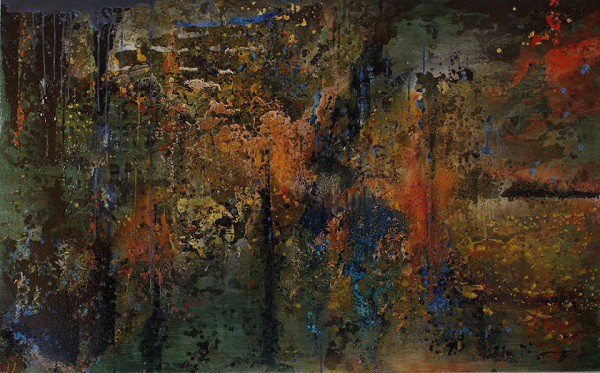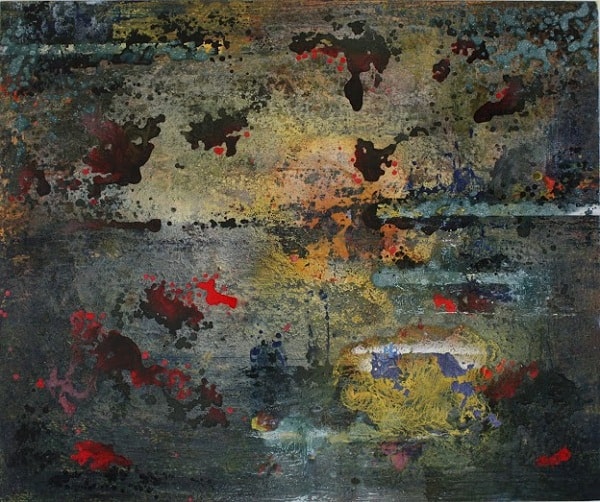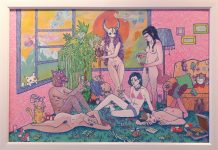With his bearded chin and pierced left ear, Tom Whitty looks every inch the artist. He dresses casually, talks quietly and occasionally seems to drift off into another world mid-conversation. Just getting him to speak about his work is difficult enough, with answers to questions often coming long after they have been asked. He is honest about not liking interviews, but put him in front of his own work and that all changes.
“Look at this area here,” he instructs me, indicating where he means as we stand in front of one of his several compositions on display. “You really have to get up close to see the detail.” I do as he says and indeed notice just how precise and content heavy this area of the piece is. “I really like this part,” he says as we compete with the other exhibits in the small but busy gallery. No one could ever accuse him of laziness, especially once they have examined his work up close. “All I want to do is paint,” he tells me. “I feel better when I paint.” Currently between studios, it is apparent just how frustrating he finds this state of affairs.

All of Tom’s works are untitled, something I admire. I ask him about this and he offers a name for one painting, which he then proceeds to rename before finally clamming up. No profound or obscure captions here then, no helpful hints towards what each piece might mean. To understand each work you just have to look and investigate for yourself, to find your own meaning in it. Abstract and stunning, I consider his art a visual treat; it entertains the eye as an explosion of colour. Each canvas is large: exciting and rewarding in equal measure. Empty spaces simply don’t exist here.
I ask him if he does any other work besides painting. “I tried my hand at performance art in University but I found that very uncomfortable. I prefer work that takes time and actually enjoy when it is not going well.” According to him, too many people consider art a commodity and too few take it seriously. “My favourite piece took almost twelve months to finish. It sold almost immediately, and I don’t have a picture of it.” For some reason this doesn’t really surprise me. Tom studied Fine Art in Newcastle University and spent six months in Istanbul in 2008 as part of the Erasmus programme. He lived for a while in Tunceli, located in eastern Anatolian, teaching children about art and ceramics. He did this for two months via the European Voluntary Service. Tom also spent time in Syria and Lebanon. “I wanted to do something different,” he says of his time moving around. Though he doesn’t ever produce much Turkish, I have a feeling there is more available to him than his silence suggests. Understatement is also something of an art with him, and it often seems he has more to say than he allows himself — perhaps that’s where his painting comes in.
“Turner would be my favourite,” he tells me when asked about which artists he likes. “His landscapes are very romantic. Then there’s Anselm Kiefer, whose desolate, moody, dark work I love. And, of course, Jackson Pollock.” Turner I know, and Pollock too, though I can’t claim to really understand his art. “Try his earlier works,” Tom advises, “they are more like Picasso and make his later works easier to access.” I take his advice, while also noting down the name Anselm Kiefer, whose work I’m not familiar with.

When pressed, Tom admits that his ideas are mostly fully formed before he even picks up his brush. Impressive as this sounds, it becomes even more so when you realise that sketches for this type of work, which is so vast and boundless, must be impossible. I want to ask him where one would even start with something like this, but I decide against it.
I’m curious about his childhood. Surely he must come from an artistic family or have very creative parents. “My mother finished her degree when she was in her early thirties. I was about eight years old then. She taught young children. My dad is about as far from artistic as you can get, he’s a mechanical engineer. It’s all straight lines and numbers with him.” Fair enough. But, I wonder, did his parents’ lack of artistic inclinations make it difficult for them to support his decision to pursue such a career? Apparently not. “Of course they worried what I was going to do with my studies, they even suggested I could teach art when I graduated. That wouldn’t have been such a bad idea in retrospect.” He is amused by this idea, smiling to himself.
Just before sitting down to write up our conversation, I learned that Tom had sold two of his paintings, about which he was naturally delighted. So if you want to catch his work while it’s still on display, I suggest you make your way to Bisanat Gallery in Beyoğlu before it’s all gone.
Eamon McHugh is a contributor to Yabangee










Fantastic!